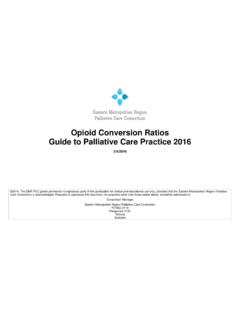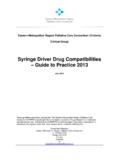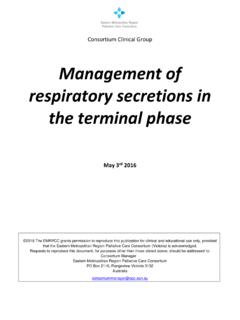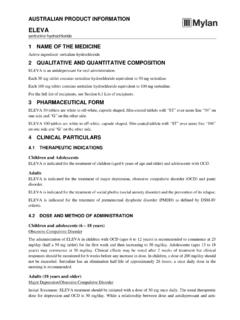Transcription of Opioid Conversion Ratios - Guide to Practice 2010
1 Opioid Conversion Ratios - Guide to Practice 2010. Released December 2010. 2010. The EMR PCC grants permission to reproduce parts of this publication for clinical and educational use only, provided that the Eastern Metropolitan Region Palliative Care Consortium is acknowledged. Requests to reproduce this document, for purposes other than those stated above, should be addressed to: Consortium Manager Eastern Metropolitan Region Palliative Care Consortium PO Box 227, Nunawading VIC 3131. Australia Final December 2010. For review June 2013. TABLE OF CONTENTS. Instructions for use 3. Disclaimer 3. General Notes 3. Oral Morphine to other oral analgesics 4. Oral opioids to parenteral opioids 4. Parenteral Morphine to other parenteral analgesics 5. Parenteral Fentanyl to transdermal Fentanyl 5.
2 Fentanyl lozenges 5. Transdermal Fentanyl to Morphine 6. Intranasal Fentanyl 6. Transdermal Buprenorphine to oral Morphine 7. Methadone 8. Abbreviations 9. References 9. Acknowledgements and Contributors 10. Summary Chart 11- 12. Eastern Metropolitan Region Palliative Care Consortium (Victoria) Opioid Conversion Guidelines 2010 2010. Page 2 of 12. INSTRUCTIONS FOR USE. Printing: It is highly recommended these guidelines are printed in colour, to aid ease of use. The access point for the current electronic version of these guidelines is at Eastern Metropolitan Region Palliative Care Consortium or Centre for Palliative Care DISCLAIMER. The information in this document is to be used as a guideline only. It is the responsibility of the user to ensure information contained in this document is used correctly.
3 These guidelines reflect current Australian/Victorian palliative care Practice and available literature at the time of the guideline release. Printed versions can only be considered up-to date for a period of one month from the printing date, after which the latest version should be downloaded from the Eastern Metropolitan Region Palliative Care Consortium website. All medication doses derived from these guidelines should be checked and prescribed by a medical doctor with appropriate experience before administering. Medication doses should be modified in response to the patient/client's clinical situation and status, including previous exposure to opioids and concurrent medications. Adhere to all legislation and professional requirements including organisational policies and procedures regarding Opioid medications and their administration.
4 All patients should be monitored closely until stable when commencing, adjusting dosage and/or switching Opioid medications. GENERAL NOTES. 1. Where there are differences in the literature regarding Opioid Conversion Ratios , Australian/Victorian references have been used. 1. 2. Pethidine has not been included in this document, as its use in palliative care is not recommended. 3. Allowing for Incomplete Cross-Tolerance - When switching from one Opioid to another, the new Opioid may have increased potency, even if from a similar class of analgesic. Dosage of the new Opioid therefore should be based upon several factors, including available equi-analgesic dose data, clinical condition of the patient, concurrent medications and patient safety. It is recommended that the new Opioid dose should be reduced by 30% - 50% to allow for incomplete cross-tolerance.
5 6,7. The patient should be monitored and assessed closely when a change is made from one Opioid medication to another. 4. When changing from one Opioid to another (when not morphine), always convert to oral morphine first. For example if converting from transdermal fentanyl to transdermal buprenorphine, first convert transdermal fentanyl to oral morphine then convert from oral morphine to transdermal buprenorphine. 5. Sufentanil has been removed from this edition. The medication is only used by specialised palliative care services as it is only available through the special access 3. scheme. Eastern Metropolitan Region Palliative Care Consortium (Victoria) Opioid Conversion Guidelines 2010 2010. Page 3 of 12. ORAL MORPHINE TO OTHER ORAL ANALGESICS. Conversion Oral to Oral Comments Ref.
6 Ratio Oral Morphine 10 mg = Oral Tramadol 50 mg Morphine to Tramadol 1:5 1. 1. Tramadol has a limited role in managing moderate-severe pain in palliative care. Morphine to Codeine 1:8 Oral Morphine mg = Codeine 60 mg 1. CONSULTANT REQUIRED. Morphine to Methadone - See methadone Conversion on p8 for more information. Morphine to Oxycodone :1 Oral Morphine 15 mg = Oral Oxycodone 10 mg 1,2,11. Oral Morphine 5 mg = Oral Hydromorphone 1 mg Morphine to Hydromorphone 5:1 3 1,2,3,11. If changing drugs start at the Conversion dose and titrate according to response. ORAL OPIOIDS TO PARENTERAL OPIOIDS (SC, IV, IM) same drug to same drug Oral Parenteral Ratio Calculation Comments Ref. Morphine Morphine 2-3:1 Oral Morphine 30 mg = Subcutaneous Morphine 10 -15 mg 1. The variability of bioavailability requires 1,3,5.
7 Oxycodone Oxycodone 2:1 Oral Oxycodone 10 mg = Subcutaneous Oxycodone 5 mg the Conversion to be conservative. Titrate 3. according to response Hydromorphone Hydromorphone 3:1 Oral Hydromorphone 15 mg = Subcutaneous Hydromorphone 5mg 1. Consultation with a palliative care Methadone Methadone 2:1 Oral Methadone 20mg = Subcutaneous Methadone10 mg 1,2,11. specialist or pain clinic is advised. Tramadol has a limited role in managing Tramadol Tramadol :1 Oral Tramadol 150 mg = Parenteral Tramadol 100 mg 1. moderate-severe pain in palliative care. Eastern Metropolitan Region Palliative Care Consortium (Victoria) Opioid Conversion Guidelines 2010 2010. Page 4 of 12. PARENTERAL (SC, IV, IM) MORPHINE TO OTHER PARENTERAL (SC, IV, IM) ANALGESICS. From To Ratio Calculation Comments Ref.
8 SC, IV, IM SC, IV, IM. 1,2,3. Morphine 10,000 micrograms = Fentanyl 100 Morphine 10 mg = Fentanyl 100 micrograms Morphine Fentanyl 100:1. micrograms Morphine 100 mg = Fentanyl 1 mg (1000 micrograms). Differing Conversion Ratios are provided in the literature 1,2,4,5. depending on the duration of Opioid exposure, the route of administration and the direction of the switch 2,5,6. Morphine Hydromorphone 5:1 Morphine 10 mg = Hydromorphone 2 mg (Morphine : Hydromorphone or Hydromorphone : Morphine). Close monitoring and titration for each individual is required. See General Note 3. Tramadol has a limited role in managing moderate-severe pain 1,2. Morphine Tramadol 1:10 Morphine 10 mg = Tramadol 100 mg in palliative care. Morphine Oxycodone 1:1 Morphine 10 mg = Oxycodone 10 mg 1,2,5,11.
9 PARENTERAL FENTANYL & TRANSDERMAL FENTANYL - same drug to same drug Ratio Calculation Ref. Parenteral Fentanyl Transdermal Fentanyl 1:1 Fentanyl 600 micrograms / 24 hours = Fentanyl patch 25 micrograms/hour 14,15, TRANSMUCOSAL FENTANYL LOZENGES. Fentanyl lozenges offer a faster onset of relief than oral or subcutaneous morphine in breakthrough pain. Transmucosal fentanyl should only be used in patients who are already receiving opioids, and are Opioid tolerant. A patient should be receiving at least 60mg of oral morphine equivalents per day, or 50 micrograms transdermal fentanyl 5. per hour, if transmucosal fentanyl is to be considered for breakthrough pain . At present, there is no direct Conversion ratio between morphine and transmucosal fentanyl. 5,7,8. The Manufacturer notes, National Prescribing Service website, and MIMS suggest using a titration method to arrive at the optimum dose, commencing with 200micrograms.
10 Eastern Metropolitan Region Palliative Care Consortium (Victoria) Opioid Conversion Guidelines 2010 2010. Page 5 of 12. TRANSDERMAL FENTANYL TO MORPHINE. Parenteral Morphine Oral Morphine equivalent Patch Strength Dose equivalent Break through pain management Ref (mg/24 hours). (mg/24 hours). Fentanyl Patch 12. 288 mcg/24 hours 10 to 15 20 to 45. microgram/hour 5mg immediate release oral morphine 1 hourly / Fentanyl Patch 25. 600 mcg/24 hours 30 to 40 60 to 100* 10mg immediate release oral morphine 1 hourly / 1. microgram/hour Fentanyl Patch 50. 1200 mcg/24 hours 60 to 80 120 to 200* 20mg immediate release oral morphine 1 hourly / 1. microgram/hour Fentanyl Patch 75. 1800 mcg/24 hours 90 to 120 180 to 300 30mg immediate release oral morphine 1 hourly / 1. microgram/hour Fentanyl Patch 100.









